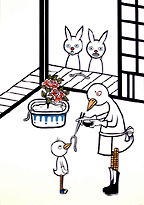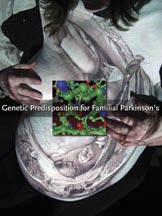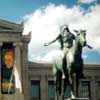Upon entering the NAO Project Gallery, one is instantly taken aback by the flawless appearance and high quality of Asuka Ohsawa’s work. Each painting consists of a tightly rendered gouache-on-paper drawing, blending together solid black and the occasional soft yellow, blue, red, or other pastel. The lines are crisp, clean, and accurate, while the overall appearance of each image resonates with a still beauty that is rarely found in most contemporary painting.
Each of Ohsawa’s paintings visually unfolds an open-ended narrative involving animal-like characters with human traits, behaviors, and physiques. These humanistic qualities are evident through their posture, 5-digit hands and feet, and accessories, such as boots, hats, handbags, and other amenities. Adding to this surreal world of a human-animal environment is the interconnected theme within each painting; that of the mother and child relationship and the passing on of life lessons. For example, in Must you be a Pig?, a mother pig passes cleaning implements on to a younger pig with a question that, along with a play on words, every young, human child hears from a parent. In another painting, aptly titled, Don’t be Silly, it won’t Wiggle in your Stomach, Ohsawa depicts a mother bird trying to feed a younger bird a worm with a pair of chopsticks. The lessons of home, health, and happiness appear here in true form.
Along with these life lessons, though, comes a fascinating twist. In most of Ohsawa’s paintings, there are additional, human-like animals observing each central scene, often voyeuristically. These characters are always of a different species than those participating in the educational lessons and they peer onto these unfamiliar households from outside doors, behind windows, or beyond the participant’s direct line of vision. In Excellent Dinner Choice, My Dear, a mother cat teaches her offspring how to catch a fish from a bathtub. There is a hungry and primal look on the young cat’s features, which gives a disturbingly realistic tone to the event. Behind a barred window, a mother and child mouse look on, mouth’s agape, with a visually apparent consciousness that includes both a fear and understanding for the life lesson in progress. Although at times, it is uncertain whether these secondary characters are suspicious, terrified, or interested in the unfolding scene, they are often outside participant’s who by chance could be affected by the lessons taking place.
In combination with the open narrative structure and tense character design, Ohsawa creates additional intrigue through her use of Japanese and American symbolism. Many of the painting’s characters are clothed in Japanese sandals, such as the geta or zori, while others are donning boots reminiscent of Wonder Woman and other classic cartoon characters. A young bunny in They think they are so smart, don’t they? runs around a mirror dressed in a Japanese kimono, while in the same painting, a second mother and child look on wearing Western styled hats and shoes. The contradiction between the Japanese and American clothing, furnishings, and tools, along with Ohsawa’s style (reminiscent of Japanese ukiyo-e prints) forces these rippling tensions and symbolic underpinnings to the forefront of the viewer’s thoughts.
One of the most interesting aspects of this exhibition is the functionality found in the whimsical quality of Ohsawa’s paintings. The reference to comic books and cuddly animals pulls the viewer into the questions and concerns that are blended into the narrative. This style creates a point of access, especially for those audience members who are unfamiliar with the issues at hand. Although, visually, the work utilizes an elegant and stylized technique, these paintings remain conceptually strong with important questions concerning culture, family and nationality. Regardless of one’s knowledge of Ohsawa’s personal experiences or cross-cultural debates, the overlying message is expansive enough to involve other societal tensions. The work can include feminists, those who struggle between two genders, bi-racial children who are torn between the expectations of two different worlds, or even the fight that takes place everyday between media-imposed expectations and those that are realistically achievable.
Links:
NAO Project Gallery
"Asuka Ohsawa: Metaphors" is on view until June 26th at NAO Project Space, 535 Albany St., Boston.
All images are courtesy of the Asuka Ohsawa and NAO Project Space
Kimberly Potvin is a Boston based artist, writer, and occasional contributor to Big Red & Shiny.




